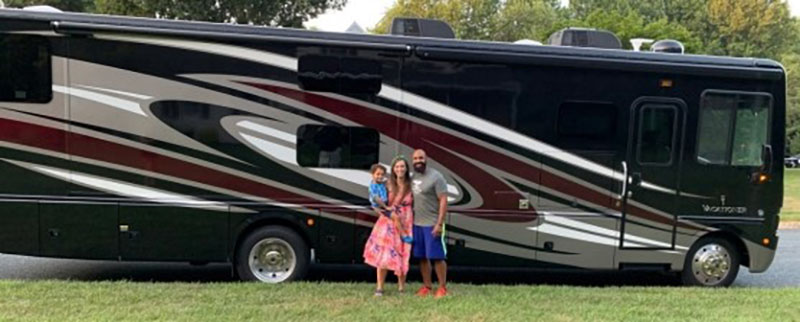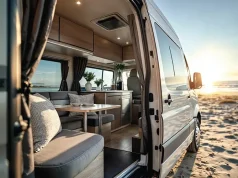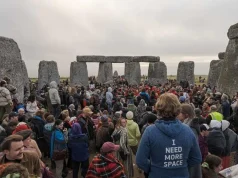Getting ready to shift into full-time RV life is a series of steps. Near the top of the list is downsizing from a house or apartment and moving into a home on wheels. For some first-hand advice, Holiday Rambler® has partnered with Spencer and Kristi from the Adventurtunity Family to share their experiences as they, along with their four-year-old son Kade and puppy Ruko Blu, explore the United States.
The family purchased a 37-foot, 2017 Vacationer® 36H from Holiday Rambler in July 2020 and started living on the road full time that September. Since then, they’ve chronicled their adventures on Instagram and the Holiday Rambler blog.
As we downsized from our 3,000-square-foot-home to a less than 300-square-foot living space, we learned A LOT! It was a process…a very long process. But we did it and you can, too. There are a few things we did really well, and there are a few things we absolutely could have done better. Now, knowing what we know, we are sharing our downsizing tips and tricks with you.
If you are planning to live full time in your RV, congratulations! If you are living in your RV for vacations and weekend getaways, these tips will still be helpful as you pack your rig.

“How to Downsize Your Home for RV Living” by the Adventurtunity Family
START EARLY
Moving out of a home packed with your most prized possessions, memories, stuff you just had to have, and junk is no easy task. First, decide if you will be getting a storage unit, keeping some things with family, or packing everything in your RV. You’ll want to determine when to start paring down and then start three months earlier than that. Seriously!
We suggest starting in one area or room and labeling everything “Save,” “Sell,” “Store,” or “Send.” “Send” means Goodwill or another donation center or to the dump. We had to do several rounds of this process in the same rooms/spaces to significantly pare down our things. We’ll admit we probably kept more than we should have, but we also purged so much more than our original first pass through each space.
IDENTIFY RV MUST HAVES
It’s helpful to identify your RV must haves by typing or writing out a list. We suggest breaking your list down into sections and assigning a quantity to each item. For example, a section would be BATHROOM and a line item would be bath towels. There are three people in our family, and we planned to bring two bath towels each, so our line item was (6) bath towels.
Once you have your RV must-haves, you can start to collect these items in a designated RV area in your home, or move them directly into your RV, if that is an option.
To give you an idea of how we packed for our family of three, here is a portion of our list.
BATHROOMS – 1.5 BATH
(6) bath towels, (3) pool towels, (6) hand towels, (4) wash clothes, (1) hair dryer, (1) curling iron, and toiletries
BEDROOMS – KING and BUNK AREA
(2) king sheet sets, (1) all season king bedding, (6) blankets, (10) pillows, (5) accent pillows, (2) twin sheet sets, (2) all season twin bedding
KITCHEN
(6) plastic plates, (6) plastic bowls, (20) count utensil set (4 settings), (1) frying pan, (1) small sauce pan, (1) large pot, (3) plastic nesting mixing bowls… these double as serving bowls, (1) collapsible colander, (2) cutting boards, cooking utensils, (4) kitchen towels.
GET CREATIVE SAVING THE SENTIMENTALS
There is no easy way to go about parting with memories and meaningful items. But, thanks to technology, we have more options when it comes to storing our favorite pieces. You can now scan, take photos, or create small memory books of your favorite possessions.
We took pictures of artwork, crafts, and other items we wanted to remember but didn’t need to keep. And, since we decided to have a storage unit, we allocated one Tupperware bin for each of us to save anything we wanted that would fit in that bin.
SELL, STORE, AND SELL SOME MORE!
There is no better time to get uncomfortable than now. It can be a tricky balance of wanting to keep furniture and other items while you are still living in your home but also wanting to sell or store them prior to your fulltime departure. Trust us and learn from our mistakes! It’s better to sell or store your big items as soon as possible. By selling items early, you have a better chance of receiving your asking price, coordinating a seamless pickup/delivery, and making more room for your save, store, sell, and send piles. If you are worried about where to sit while still living in your home, consider using your camp chairs and collapsible furniture that you’ll pack in your RV.
If you are storing large pieces, we recommend putting them in your storage unit first, so you know what space, you have to work with for boxes and smaller items. Another tip: Don’t get hung up on price. Your items are only worth what someone is willing to pay for them. Better to let go of them for some cash rather than holding on to them, only to possibly donate them later.
DON’T STUFF THE BUS
If you’re traveling in a Class A RV, the good news is you’ll probably have a decent amount of space to store all of your items. However, we recommend avoiding the urge to fill every inch of it! You will want to leave room for changing out seasonal gear and additional items you might acquire along the way.
For example, this is our first spring and summer traveling full time. We decided we wanted to have some fun water toys and got two inflatable paddleboards. If all of our storage spaces were full, we wouldn’t have had room to add and store our boards.
NOTHING IS PERMENANT
To set yourself up for success, allow plenty of time for downsizing, create a plan, be realistic, and remember nothing is permanent. You’ll quickly realize the items you use frequently and those you don’t. If you packed too much, you can always purge later and, if you wish you had something, you can always add it along the way.
Eight months in and we are still shuffling items, utilizing our space differently, and adding new items. We have even added a golden retriever puppy to the mix and found room for him and the things he needs! The biggest thing to realize is this: the experiences, memories, and friends you will acquire along your RV journey will be far more valuable than any of the physical things you put in it. Bring what you need, a few things you want, and, most importantly, an open heart and mind ready to be filled with all the amazing experiences you will find down the road!





